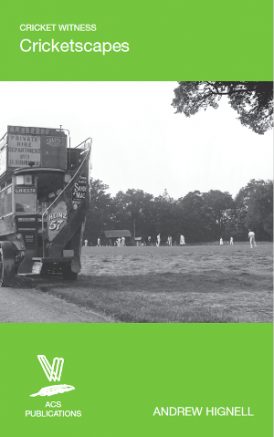Cricketscapes
Martin Chandler |Published: 2020
Pages: 132
Author: Hignell, Andrew
Publisher: ACS
Rating: 3.5 stars

I will say immediately that, being around five years of age at the time of it, I cannot now and indeed never have been able to remember the conversation with my father that this book brought to mind almost immediately after I had opened it. It was a story he loved to tell me nonetheless, as to how one day he found me in my room with a Wisden on one side of me, and a News of the World Football Annual on the other.
Looking, apparently, deeply troubled in the way that five year olds do when their grey matter is being over exerted, I asked the question; ‘if you have county cricket for the best, and league cricket for everyone else then why, if there is league football for the best is there not county football for everyone else? In the absence of a satisfactory answer from my all-knowing father my ‘little furrowed brow’ apparently remained so for several days.
In the end, a couple of decades later, I did find a way to end my father’s enthusiasm for the regular retelling of this story by pointing out that whilst he may have found the episode entertaining, he ought to bear in mind that his failure to even attempt to answer the question did not reflect well on his parenting skills. It had taken twenty years, but I had finally netted an equaliser.
Sadly we lost my father many years ago now, but as soon as I began to read Cricketscapes that particular memory came flooding back as the first chapter of Andrew Hignell’s book deals with precisely that question.
From that excellent start the narrative then stays with the county game and looks at the venues where the counties play. The various chapters break the last 150 years down into a number of periods, with a particular summer selected for each period.
For each of the selected seasons, 1895, 1911, 1931, 1951, 1971, 1991 and 2011, Hignell divides the counties into various groupings, in the case of 2011 separately for Championship matches and T20. There are those who pay all their matches at one venue, those that play all but occasionally at their headquarters, all the way down to the likes of Kent and Essex who, for many years, would share their home fixtures around a number of grounds without any one being dominant.
Which counties have fallen into which category has, over the years, changed rather more frequently than might be expected. Hignell draws out the trends and makes some interesting observations about many individual venues, both past and present.
As that brief summary suggests there is little in the early chapters of the book that courts much in the way of controversy, but that all starts to change in the 1960s once limited overs cricket begins, and the more so when Hignell gets nearer to the present day and the seismic change that The Hundred, and its move away from the traditional county structure has brought.
As one of the many whose knee jerk reaction is to hate anything to do with The Hundred Hignell’s basic position, that the old county structure is changing and must continue to change, horrifies me. Nothing he writes changes that, but I have to concede that he puts forward a well-reasoned and sound case in support of his views. I will just have to hope that, unlikely as it seems, something will come to pass to prove him wrong.
Cricketscapes is one of the titles in the ACS Cricket Witness series, and its subject matter might on its face seem to be a relatively unimportant aspect of cricket in England. In reality however, given that the county structure is, for good and ill, fundamental to how cricket has developed here, it raises questions to which the answers are likely to change the game irrevocably. For that reason, and for the neat and objective way in way in which the book is set out, it is an important one, and a title that is still available from the publisher.






Leave a comment